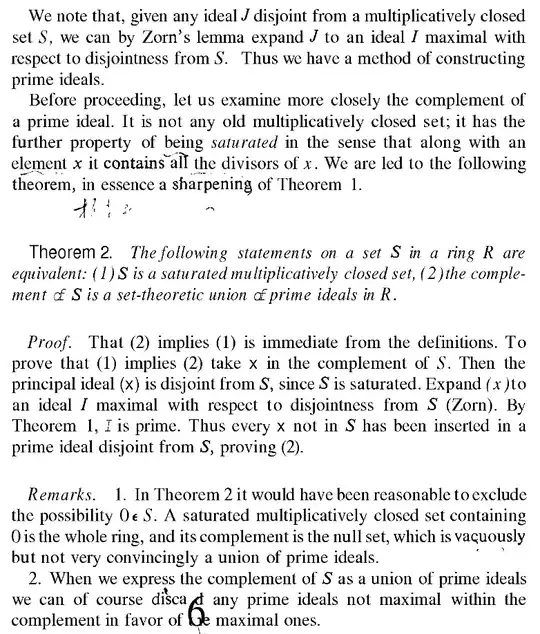We must assume $\rm 0\not\in S $ since $\rm\: 0\in S\: \Rightarrow\: 0 \not\in \overline S := R\setminus S,\: $ so $\rm\:\overline S\:$ is not an ideal. A simple Zorn lemma argument (see below) shows that, since $\rm\:S\:$ is multiplicatively closed, the ideal $\rm\{0\}\subset \overline S\:$ can be enlarged to an ideal $\rm\:P\:$ maximal w.r.t. to exclusion of $\rm\:S,\:$ and such an ideal must be prime. Therefore $\rm\: P = \overline S,\:$ else we could enlarge $\rm\:S\:$ to the monoid $\rm\:\overline P,\:$ contra maximality of $\rm\:S.\quad$ QED
Note $\: $ The prime $\rm\:P\,$ above may be alternatively constructed as the contraction of a maximal ideal $\rm\:Q\:$ of the localization $\rm\: R_S = S^{-1} R.\: $ $\rm\:Q\:$ exists since $\rm\ 0\not\in S\ \Rightarrow\ R_S \ne \{0\}.\:$ Generally, there is a bijective order-preserving correspondence between all prime-ideals in $\rm\:R_S\:$ and all prime ideals in $\rm R$ disjoint from $\rm\:S,\:$ see Theorem 34 in Kaplansky's Commutative Rings. His Theorem $1$, p. $1$ is the above-invoked form of this result (employing no localization theory). I've appended it below.
Let $\,\overline I\,$ be the set-theoretic complement of an ideal $\,I.\,$ Then the definition of a prime ideal can be recast as follows: $\,\ I\,$ is prime $\iff$ $\, \overline I\,$ is multiplicatively closed (and nonempty). $ $ Now it goes without saying that $\,I\,$ is an ideal maximal with respect to the exclusion of $\,S = \overline I.\,$ Krull discovered a very useful converse.
Theorem $\bf 1\ \ $ Suppose that $\,S\:$ is a nonempty multiplicatively closed set in a ring $\,R,\,$ and suppose that $\,I\:$ is an ideal in $\,R\,$ maximal with respect to the exclusion of $\,S.\,$ Then $\,I\:$ is prime.
Proof $\ \ $ Given $\,ab\in I\,$ we must show that $\,a\,$ or $\,b\,$ lies in $\,I.\:$ Suppose the contrary. Then the ideal $\,(I,a)\,$ generated by $\,I\,$ and $\,a\,$ is strictly larger than $\,I\,$ and therefore intersects $\,S.\,$ Thus there exists $\,s\in S\,$ of the form $\,s = i + r a\,\ (i\in I,\, r\in R).\,$ Similarly $\,\hat s = \hat i + \hat r b\in S\,\ (\hat i\in I,\, \hat r\in R).\,$ But then
$$ i,\hat i,ab\in I\ \Rightarrow\ s \hat s = (i+ ra)(\hat i + \hat r b)\in I\cap S,\ \ {\rm contradiction}\quad {\bf QED}$$
We note that, given any ideal $\,J\,$ disjoint from a nonempty multiplicatively closed set $\,S,\,$ we can by Zorn's lemma expand $\,J\,$ to an ideal $\,I\,$ maximal with respect to disjointness from $\rm\,S.\,$ Thus we have a method of constructing prime ideals.

